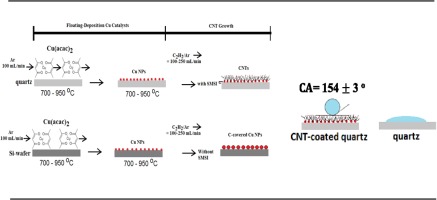Our official English website, www.x-mol.net, welcomes your
feedback! (Note: you will need to create a separate account there.)
Growth of a Superhydrophobic Multi-walled Carbon Nanotube Forest on Quartz Using Flow-vapor-Deposited Copper Catalysts
Carbon ( IF 10.5 ) Pub Date : 2017-11-01 , DOI: 10.1016/j.carbon.2017.09.023 Chung-Hsuan Hsiao , Jarrn-Horng Lin
Carbon ( IF 10.5 ) Pub Date : 2017-11-01 , DOI: 10.1016/j.carbon.2017.09.023 Chung-Hsuan Hsiao , Jarrn-Horng Lin

|
Abstract Although studies on carbon nanotube (CNT) growth have made great advancements, direct growth of highly dense CNTs on desired substrates or positions remains an important challenge. Herein, we report a simple method to directly fabricate a CNT forest on a quartz surface using a copper catalyst at 850 °C under a stream of argon-diluted ethanol. Copper nanoparticles (NPs) are used as catalysts, which are generated through flow-vapor-deposition of copper (II) acetylacetonate on a thermal-treated SiO2 (quartz) or Si (silicon wafer) surface. Dense tangled CNT forms on the quartz surface. However, when a silicon wafer is used as the substrate, the only product is a carbon-covered copper NPs instead of CNTs. The growth yield of CNTs is approximately 10.5 g CNT/g Cu⋅h as characterized by thermogravimetric analysis, which is remarkably high compared with those achieved by conventional copper-based catalysts. The stronger metal-support interaction of copper NPs with quartz is suggested to be the key factor for CNT growth. Bamboo-like MWCNTs (BMWCNTs) are the main structures formed through transportation of copper NPs during CNT formation as evidenced by HR-TEM micrographs. Moreover, CNT-grown quartz has superhydrophobic features with a contact angle of 154°, revealing its promising application in self-cleaning coatings.
中文翻译:

使用流动气相沉积铜催化剂在石英上生长超疏水多壁碳纳米管林
摘要 尽管对碳纳米管 (CNT) 生长的研究取得了很大进展,但在所需基板或位置上直接生长高密度 CNT 仍然是一个重要的挑战。在此,我们报告了一种简单的方法,在 850°C 下在氩稀释的乙醇流下使用铜催化剂在石英表面上直接制造 CNT 森林。铜纳米颗粒 (NPs) 用作催化剂,通过在热处理的 SiO2(石英)或 Si(硅晶片)表面上流动气相沉积乙酰丙酮酸铜 (II) 生成。在石英表面形成密集缠结的 CNT。然而,当使用硅晶片作为基板时,唯一的产物是碳覆盖的铜 NPs 而不是 CNTs。通过热重分析表征,碳纳米管的生长产量约为 10.5 g CNT/g Cu⋅h,与传统的铜基催化剂相比,这是非常高的。铜纳米颗粒与石英之间更强的金属-载体相互作用被认为是碳纳米管生长的关键因素。如 HR-TEM 显微照片所证明的,竹状 MWCNTs (BMWCNTs) 是在 CNT 形成过程中通过铜 NPs 的传输形成的主要结构。此外,碳纳米管生长的石英具有接触角为 154° 的超疏水特性,显示其在自清洁涂层中的应用前景。
更新日期:2017-11-01
中文翻译:

使用流动气相沉积铜催化剂在石英上生长超疏水多壁碳纳米管林
摘要 尽管对碳纳米管 (CNT) 生长的研究取得了很大进展,但在所需基板或位置上直接生长高密度 CNT 仍然是一个重要的挑战。在此,我们报告了一种简单的方法,在 850°C 下在氩稀释的乙醇流下使用铜催化剂在石英表面上直接制造 CNT 森林。铜纳米颗粒 (NPs) 用作催化剂,通过在热处理的 SiO2(石英)或 Si(硅晶片)表面上流动气相沉积乙酰丙酮酸铜 (II) 生成。在石英表面形成密集缠结的 CNT。然而,当使用硅晶片作为基板时,唯一的产物是碳覆盖的铜 NPs 而不是 CNTs。通过热重分析表征,碳纳米管的生长产量约为 10.5 g CNT/g Cu⋅h,与传统的铜基催化剂相比,这是非常高的。铜纳米颗粒与石英之间更强的金属-载体相互作用被认为是碳纳米管生长的关键因素。如 HR-TEM 显微照片所证明的,竹状 MWCNTs (BMWCNTs) 是在 CNT 形成过程中通过铜 NPs 的传输形成的主要结构。此外,碳纳米管生长的石英具有接触角为 154° 的超疏水特性,显示其在自清洁涂层中的应用前景。







































 京公网安备 11010802027423号
京公网安备 11010802027423号